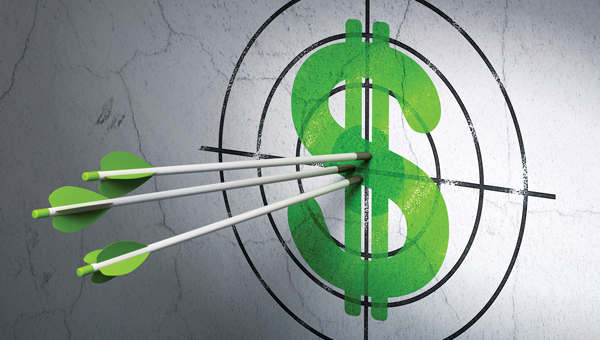My direct mail postcard company has worked with nearly 900 landscaping businesses nationwide. Every time we run a new campaign, we follow up to see what kind of results the campaign achieved. We’re sitting on a goldmine of tried-and-true marketing principles for landscape professionals, and I’m happy to share it with you here.
Meet “The Big Three” of direct mail postcard campaigns: size, design and list.
1. Size
“What size postcard is best?”
“Can I just use a smaller card?”
“What’s the benefit of a bigger card anyway?”
We can disagree on a lot of things about marketing, but can we all agree that a larger card is easier to see? This is why choosing the right size for your card is crucial. There are some industries that are more competitive than others. For businesses in those industries, a bigger card may be necessary to get noticed in the mailbox.
Many direct mail companies offer a variety of sizes for their clients to choose from. Usually the options look something like this: Small (4 in. by 6 in.), Medium (5 in. by 8 in.), and Large (6 in. by 11 in.). The names may vary (jumbo, regular, value, etc.). Not sure what size you need? Answer these questions to find out:
- How much do other companies in your industry market?
- Not at all/I’m the only one. (You can lean towards a smaller card.)
- Light to moderate amount. (Lean toward a larger card.)
- Moderate to heavy amount. (You need a large card.)
- Do your competitors also mail postcards?
- No. (You can lean towards a smaller card.)
- Yes. (You need a large card.)
- How much explaining does your offer require?
- Not that much/easy to grasp. (Smaller card is fine.)
- A little background info. (Medium should do the trick.)
- A lot/details are important. (Go big or go home.)
You’re the best person to answer these questions about your own business, but in my experience it’s better to err on the side of a larger card. That way you know your card is substantial enough to make an impact in the mailbox.
2. Design
Getting attention is one thing. Converting that attention into interest and action is an entirely different thing–and that’s the job of the postcard’s design and copywriting.
Here are the 10 elements every marketing postcard needs to be successful:
- Clear headline
- Supporting graphic
- Color that pops
- Intriguing subheadings on the back that lead into benefits
- Benefits!
- Enticing offer
- Your name and logo
- Call to action and/or expiration date for the offer
- Contact information–website, map, phone number
- Return address
Elements 1, 2 and 3 keep your prospect’s attention and spark their interest. It’s vital to be absolutely clear with your headline and images. The reader must know within two seconds who you are and what you’re offering them.
Elements 4, 5 and 6 take the prospect from passively interested to actively interested (i.e. ready to call, go online, etc.). A compelling subheading should lead into your body copy, which you must fill with the benefits of your product or service. Then, hit them with an offer that’s just too good to pass up.
Here are a few offers our clients have used successfully:
- 10 percent to 50 percent off a project/package/service
- Free estimate/analysis (paired with additional offers)
- First mow free
- Lawn maintenance packages starting at $X ($90 to $100/month)
- Free/discounted complimentary product (fertilizer application, plants, aeration, lime, etc.)
Elements 7, 8, 9 and 10 are the closers. Now that the prospect is intrigued and ready to take you up on your offer, they need to be able to contact you. You need to give them every piece of contact information you have.
Then comes one of the most important elements: the call to action. This is critical, because unless you tell people exactly what they need to do, they’ll simply do nothing. Sounds weird, but it’s true.
3. List
When it comes to The Big Three, last is certainly not least. The mailing list is actually the most important. You could choose the right sized postcard, design it with perfection and not get a single response if you mail it to the wrong prospects. You cannot afford to get the list wrong.
Creating an effective mailing list hinges on finding your “ideal prospect.” Do you cater to only high-end homes in your area? Maybe you only service commercial properties? Once you identify exactly who your ideal prospect is, you can get a list matching that criteria. You can get extremely specific with your targeting too. You can target households worth over $200,000, whose residents’ collective income is over $150,000. Or maybe male homeowners between the ages of 30-65, who make over $100,000 a year. You see my point. The more specifically you can target your prospects, the more relevant you can make your postcard for that particular group. The more relevant you can make your marketing, the more effective it is.
Our clients have success with the following list types:
- Home value (based on ideal prospect: wealthy, middle class, etc.)
- Income level (based on ideal prospect)
- Carrier routes (only if everyone on the route qualifies as a prospect!)
If you want your marketing to start bringing in major revenue returns this spring, it’s time to implement The Big Three. Once you do that, just keep at it. Direct mail is a repetitive medium, so you can’t just mail once and expect to break the bank with your return. But be consistent and The Big Three will carry you to your best spring yet.

